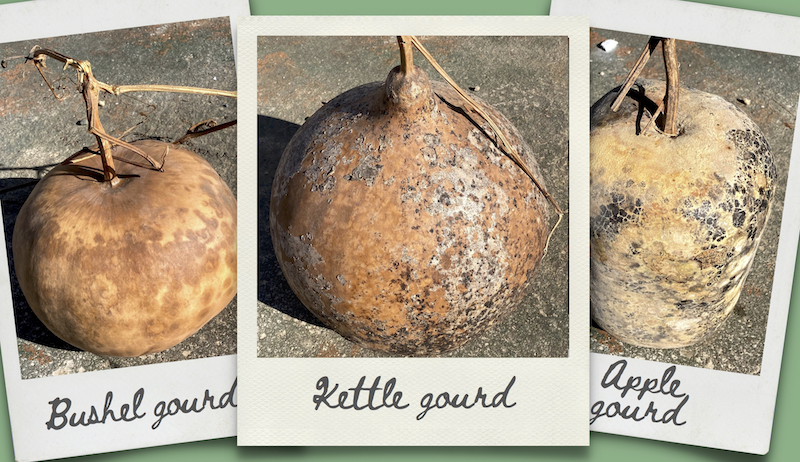
Some of Bobbie Lowe’s gourds are warty. Others are smooth. There are gourds as big as basketballs and gourds as small as chicken’s eggs. “I like to say we have 57 different varieties—like the ketchup,” Bobbie Lowe says. Together, she and her husband, Ben Lowe, own Benjamin’s Landing at Lowe Farms in Pylesville, Maryland.
They’ve been growing hundreds of gourds there since 2007.
Long before that, however, Bobbie used to grow and sell floral bouquets. She began growing gourds to use as less-breakable containers for her bouquets. “I got intrigued by how many different [gourd] sizes and shapes there were,” she says. “Eventually, the gourds overtook the flowers!”
Taking Shape
That’s understandable considering just how versatile dried gourds can be. Although there are myriad seed types available, hardshell gourds (from the genus Lagenaria) fall into a few main categories. Generally, there are bottle- or birdhouse-style gourds, dipper gourds, basket gourds and “snake” gourds.
Bottle or birdhouse gourds usually have a wide, bulb-like base, a slender mid-section, and another wide, bulb-like section on top. Some types include Mexican, Indonesian and Chinese bottle gourds, as well as martin, swan and penguin gourds.
As for dipper gourds, these have one main, bulb-like section at the bottom and a long, skinny neck. Some seed types include Marenka or dinosaur gourds and short-, long- and extra-long-handled dippers.
Basket or container gourds are often large and very rounded. Some of these include bushel, kettle, canteen-style, apple and tobacco box varieties.
And, as the name suggests, snake gourds are very long and skinny. As they grow, it’s possible to train these gourds into spirals and other interesting shapes.
Read more: Learn how to (safely!) clean hardshell gourds for fun craft projects.
Best for Beginners?
After they’ve been harvested and dried, hardshell gourds can last indefinitely. Crafters can carve, paint and even burn designs into the gourds’ woody walls. And, depending on their shape, gourds can become functional vases, baskets, keepsake boxes, musical instruments and more.
Not sure just what kind of gourd to try? Whether you want to craft some yourself or sell homegrown gourds to others, Lowe suggests apple, martin and bottle-style gourds. “Those are the three that are the most popular,” she says. “If [crafters] want to cut into them, the shells aren’t as hard.”
She continues, “If they’re good with a drill and a Dremel, then I would add a cannonball to that. The cannonball shell is very hard compared to the other three. Those are the ones that you’ll see mostly at the craft shows.”
Get Growing
Certain hardshell gourds require a lengthy growing season to reach maturity. As a result, Lowe starts some of her gourd seeds inside her greenhouse as early as April. To aid germination, she soaks her gourd seeds before planting.
And, she cautions, germination for some types can take up to four weeks. “Mini Nigerian bottle gourds take a while to germinate,” she says. “And cannonball [gourds] seem to take forever.”
Lowe plants her gourds on about two acres each year. “The gourds need air and plenty of room,” she says. “I plant mine at least 4 1/2 feet apart with 8-foot rows from center to center.”
Gourd plants are susceptible to powdery mildew and other fungal and bacterial diseases. They’re also attractive to cucumber beetles, squash bugs and squash vine borers. Ensuring plants aren’t too crowded can help keep some pests in check.
Companion planting with marigolds can help, too.
Gourds also require about an inch of water each week. When watering, take care not to splash the leaves. Instead, direct water only to the root zone, as this can help to prevent the spread of soil-borne disease.
Read more: Grow your own luffa gourds to sell or use yourself.
Extra Steps
To boost the number of gourds you produce, you’ll need to trim the end of each plant’s main vine. “If you have 10 feet of vine, you can snip off 8 inches and be safe,” Lowe says. Doing so encourages branch growth—and additional female flowers.
Besides the gourds themselves, Lowe began selling gourd seeds several years ago. To ensure its purity, she hand-pollinates individual blooms. “The female flower opens one evening, and that’s it,” she says. “You go out when the sun sets and hand-pollinate from the male to the female.”
Then she either tapes the just-pollinated blossom shut or places a small nylon bag around it. “The bag is to keep any other insects out,” she explains. “After 24 hours, you can take the bag off.”
Want to save or sell your own gourd seed? If you’re growing multiple varieties, you’ll need to take similar precautions to avoid cross-pollination. Finally, when purchasing gourd seeds, make sure they came from similarly hand-pollinated plants.
And most important of all? Be patient. “If they plant a gourd [seed] in April, it’s going to be the following June—not that first June but the second June—until their gourds are dried and ready to craft,” Lowe says. “It takes a long time.”




